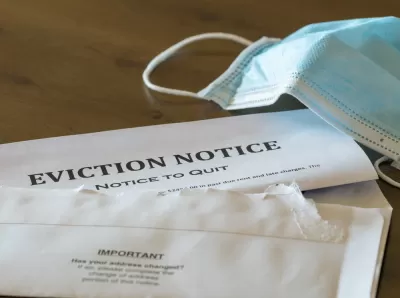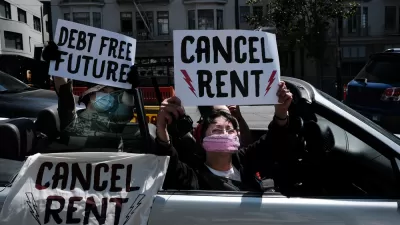A damning investigation reveals the immense financial resources that states could have spent on rent relief but failed to do so, whether willfully or not.

Millions of renters have spent the pandemic "facing possible eviction despite bold promises by governors to help renters after Congress passed the sweeping CARES Act in March 2020," according to an investigative report by Sarah Kleiner, Taylor Johnston, and Michael Casey for the Center for Public Integrity.
The headlining figure of the story: $425 million in promised rental assistance failed to reach the hands of tenants and landlords. "Nationwide, state leaders set aside at least $2.6 billion from the CARES Act’s Coronavirus Relief Fund to prop up struggling renters, but a year later, more than $425 million of that — or 16% — hadn’t made it into the pockets of tenants or their landlords," according to the investigation.
The tale of bungled and inadequate protections for renters during the pandemic continues: "The federal government had an eviction moratorium in place for the majority of 2020 and the first half of 2021, but landlords across the country have found creative ways around it. People in communities of color have been far more likely to receive eviction notices during the pandemic than people in white neighborhoods…"
The story begins by focusing on the example of North Carolina, where programs and funding were slow, obstructed, or deliberately sabotaged. But other states are included in this analysis too—like Georgia, West Virginia, Tennessee, and Alabama, which all decided not to set up statewide rent relief programs in 2020. The report also finds evidence of some states spending rent relief funds for other Covid-related purposes.
The damage to all of this neglect can be measured in lives. Diane Yentel, executive director of the National Low Income Housing Coalition, is quoted in the article describing research showing that "where eviction moratoriums were allowed to expire and tenants were evicted for nonpayment of rent, it led to increases in deaths from COVID-19."
The article also credits a dozen states for allocating all of the rental assistance from the Coronavirus Relief Fund by March 31.
FULL STORY: MORE THAN $425 MILLION PROMISED FOR RENTAL ASSISTANCE DIDN’T MAKE IT TO TENANTS OR THEIR LANDLORDS

Maui's Vacation Rental Debate Turns Ugly
Verbal attacks, misinformation campaigns and fistfights plague a high-stakes debate to convert thousands of vacation rentals into long-term housing.

Planetizen Federal Action Tracker
A weekly monitor of how Trump’s orders and actions are impacting planners and planning in America.

In Urban Planning, AI Prompting Could be the New Design Thinking
Creativity has long been key to great urban design. What if we see AI as our new creative partner?

Pedestrian Deaths Drop, Remain Twice as High as in 2009
Fatalities declined by 4 percent in 2024, but the U.S. is still nowhere close to ‘Vision Zero.’

King County Supportive Housing Program Offers Hope for Unhoused Residents
The county is taking a ‘Housing First’ approach that prioritizes getting people into housing, then offering wraparound supportive services.

Researchers Use AI to Get Clearer Picture of US Housing
Analysts are using artificial intelligence to supercharge their research by allowing them to comb through data faster. Though these AI tools can be error prone, they save time and housing researchers are optimistic about the future.
Urban Design for Planners 1: Software Tools
This six-course series explores essential urban design concepts using open source software and equips planners with the tools they need to participate fully in the urban design process.
Planning for Universal Design
Learn the tools for implementing Universal Design in planning regulations.
planning NEXT
Appalachian Highlands Housing Partners
Mpact (founded as Rail~Volution)
City of Camden Redevelopment Agency
City of Astoria
City of Portland
City of Laramie





























